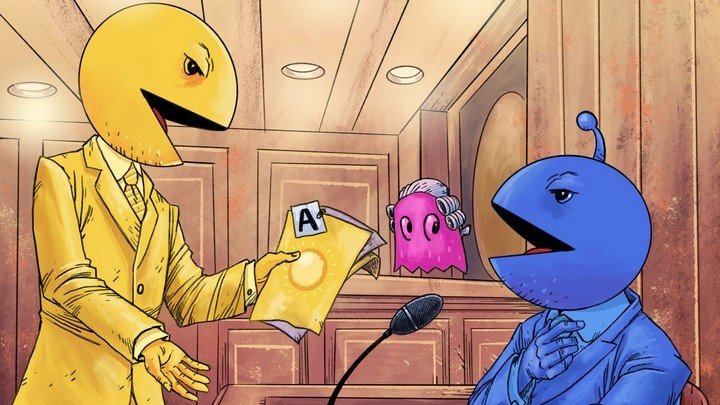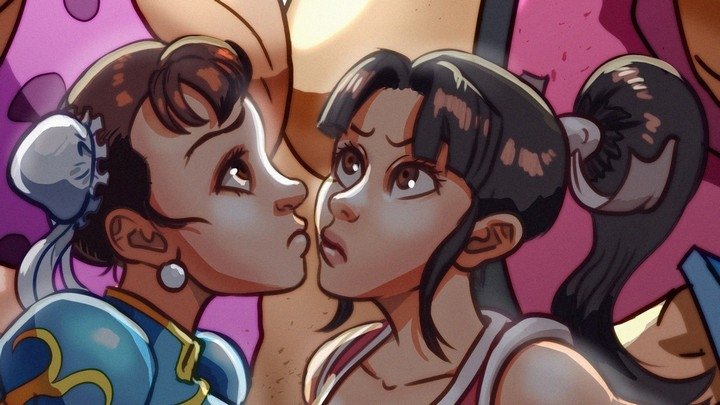Retro Re-release Roundup, week of December 24, 2020
Merry Aleste-mas, one and all.
Today's xmas-adjacent roundup features plenty of fantastic games as it is, but I'd like to throw in one more that didn't make it: Super Real Mahjong LOVE 2~7 for PC, the uncensored, too-horny-for-console versions of all your favorite(?) arcade strip mahjong games that may or may not have been delayed, or cancelled, or something, but I'll leave that to investigate on your own. Either way, someone's holiday was just ruined. You're welcome.
ARCADE ARCHIVES
Gradius III
- Platform: Nintendo Switch, PlayStation 4 (worldwide)
- Price: $7.99 / €6.99 / £6.29
- Publisher: Hamster / Konami
What's this? The ruthless and divisive third arcade entry in Konami's classic side-scrolling shooting game series, originally released in arcades in late 1989, substantially rearranged for SNES and later ported to PS2 and PSP as part of various compilations. Hamster has gone above and beyond for this release, with many specific enhancements that go beyond the usual Arcade Archives feature suite, including a thorough stage/checkpoint/loop select option, the ability to toggle visible hitboxes and reduce the hitbox of the player ship and a granular set of toggles for many of the game's very specific "quirks".
Why should I care? Gradius III's grueling difficulty was not merely a consequence of design but of many technical shortcomings, ambiguous hit detection and unpredictable slowdown among them, so the additions and options added by Hamster to this release are not just welcome but essential for allowing the average player to squeeze any amount of fun out of the game (and trust me, it is fun).
Useless fact: Hamster's deluxe treatment of Gradius III is due in part to it being their 200th consecutive weekly Arcade Archives release. Ain't that somethin'?
G-MODE ARCHIVES
- Platform: Nintendo Switch (Japan)
- Price: ¥500
- Publisher: G-MODE
What's this? A tokusatsu-themed training sim, developed by Matrix Software and published by G-MODE for Japanese feature phones in 2005; players are tasked with auditioning and recruiting various members for their sentai squad, training them through the week and filming a sentai show every Sunday, with the direction and effectiveness of your training directly reflected in the outcome of the filming sessions.
Why should I care? You're curious to see how Chroma Squad might've played if it had been designed a decade earlier for vastly more limited hardware.
Useless fact: As with many of the feature phone games of this era, Oranger's sequel was not a direct mechanical followup but instead took the form of a match-3 puzzle game.
NEO GEO POCKET COLOR SELECTION
- Platform: Nintendo Switch (worldwide)
- Price: $7.99 or equivalent
- Publisher: SNK / Code Mystics
What's this? Yumekobo's super-deformed handheld adaptation of Real Bout Fatal Fury 2, the final pre-timeskip Fatal Fury game, originally published in 1999; this game features 11 characters (plus two unlockable characters) from RBFF2, including popular newcomer Li Xiangfei and unpopular-but-still-rad Rick Strowd, as well as the NGPC's typical simplified two-button press-or-hold input system.
Why should I care? First Contact is a relatively unadorned conversion that lacks the more involved single-player content that came to define other NGPC fighting game conversions, but it is the only game that lets you play as B.Jenet's lackey Lao, so it has that going for it.
Helpful tip: Alfred, the secret boss from Real Bout 2 and protagonist of PS conversion Dominated Mind, can be fought by reaching stage 9 without using a continue and winning at least 3 rounds with a desperation move or 5 rounds with a super move, and defeating him will unlock him as a playable character. Additionally, once Alfred is unlocked, you can play as the hidden, 2P-exclusive character Lao by placing the cursor on Alfred's character select portrait and holding B (or the equivalent of B on your Switch controller) for over 2 seconds.
OTHER
- Platform: Nintendo Switch, PlayStation 4, Game Gear Micro (Japan)
- Price: ¥4,500 (digital) / ¥6,800 (standard) / ¥12,800 (limited edition).
- Publisher: M2
What's this? A collection of five 8-bit Sega-hardware titles from the seminal late-'80s/early-'90s shooting game series Aleste, originally developed and published by the defunct studio Compile and now owned by emulation specialists M2 and reissued as part of the M2 ShotTriggers label; each game has been enhanced with "gadget" displays on either side of the screen and comes equipped with several game-specific options and settings (including an option to remove flicker and slowdown), a rewind feature, online leaderboards, various screen/border options and a training mode-esque "Aleste Challenge" mode. (First-print versions of the standard retail release include an "Aleste History" interview book, while the limited-edition bundle also includes an exclusive white Game Gear Micro containing all the same games as the collection, a Big Window Micro and a GG Aleste 3 art/documents book.)
Which games are included? Aleste Collection includes four classic titles: the original Sega Mark III version of Aleste (and the corresponding Master System version, Power Strike), the two Game Gear titles GG Aleste and GG Aleste II (which includes the overseas version, Power Strike II) and the PAL/Brazil-exclusive Master System sequel to Aleste, confusingly also named Power Strike II; additionally, this collection also includes the brand-new GG Aleste 3, an original Aleste game built from scratch by a small team of veteran shooting game developers, designed to run on genuine Game Gear hardware. (All five games are also present on the limited-edition Game Gear Micro.)
Why should I care? While this collection eschews the Aleste series' more recognizable 16-bit legacy, as well as its MSX roots, the games on offer are all among the most well-crafted and technically impressive shooting games ever made for their respective platforms, and the brand-new GG Aleste 3 pushes the absolute limits of expressiveness on Game Gear, on top of everything else. (Put another way: did you ever play M.U.S.H.A or Space Megaforce, or even Zanac or Blazing Lasers, and wish there were more games like those? Here's five more games like those.)
Useless fact: This collection is an appetizer for M2's upcoming original Aleste game, Aleste Branch, which was initially and tentatively scheduled for release around this time — when M2 was presented with the opportunity to release an Aleste-themed Game Gear Micro but realized they wouldn't have Aleste Branch finished in time for the tie-up, they produced this collection instead... and in the interim, somehow managed to make a new Game Gear game in that same timeframe.
BIT.TRIP series on Switch
- Platform: Nintendo Switch (worldwide)
- Price: $4.99 each or equivalent
- Publisher: Choice Provisions
What're these? Ports of all six games in Choice Provisions' darling series of minimalist, chiptune-centric titles, BIT.TRIP — Beat, Flux, Core, Void, Runner and Fate — originally released for the WiiWare service and later ported to 3DS, Playstation 4 and PlayStation Vita, with additional per-title ports for PC and Mac.
Why should I care? You forgot that there were games in this series that weren't autorunners.
Useless fact: You're probably aware of BIT.TRIP Runner's canonical sequels, BIT.TRIP Presents... Runner2 and Runner3, but you may not be aware that the most recent Bubsy game was developed by Choice Provisions and is heavily derivative of Runner3, making it both the best Bubsy game ever made and the worst BIT.TRIP game, respectively.
ROM HACKS & TRANSLATIONS
"Project FastROM" SNES/SFC conversion process starring Super Castlevania IV by Vitor Vilela

There are many reasons a SNES game might be prominently afflicted by slowdown — in many cases, the system may be straining under the weight of overly ambitious (or simply sloppy) programming, but there's an equally likely chance that said game may have been designed for a cheaper, and subsequently slower-to-read, ROM. SA-1 enhancement patch creator Vitor Vilela has devised a process that should drastically simplify converting "SlowROM" games to "FastROM" speeds and, in the process, eliminating or lessening the slowdown present in the SNES library's earlier entries in particular... and, if you'd rather not attempt this process yourself, he came prepared with a Super Castlevania IV patch, just in case.
Super Robot Taisen OG: Original Generations (PlayStation 2) translation patch by Kingcom

The Super Robot Taisen OG sub-series of tactical mecha RPGs remain the only Super Robot Wars games to be officially released in the west, and so the PS2 remake of the first two GBA OG titles has been something fans have waited, and waited, and waiiiiited to see translated for almost fifteen years... and here it is, just in time for xmas. Right on.
Tetris: The Grand Master ZN2-to-PlayStation conversion patch by 115
The vast majority of games developed for Sony's ZN series of PlayStation-based arcade hardware received official PS ports, but due to licensing issues, Arika's Tetris: The Grand Master has remained stranded in arcades for over 20 years, and with arcade PCB prices recently skyrocketing in the wake of the pandemic, this new conversion patch, which allows the game to play on stock PlayStation hardware, is right on time. (The sequels run on different hardware, so don't expect to see them converted to PS-compatible format.)



